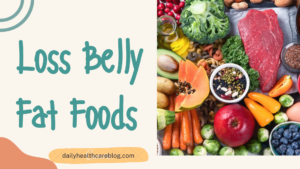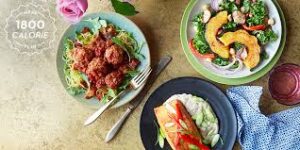Unveiling the Science: A Comprehensive Guide to Loss Belly Fat Foods
Introduction:
Traveling a road against the stomach fat is not only about the appealing jeans, but also a personal health and wellness. This detailed guide will dive into a specific topic that is belly fat loss foods and it will illuminate the knowledge and tools to help you be more informed when making dietary choices that are intended to have a flatter and healthier midsection.
Understanding the Loss Belly Fat Foods:

Visceral fat, which is also known as belly fat, is no longer an aesthetic problem only. It becomes a serious health risk such as cardiovascular disease, insulin resistance, and a range of metabolic disorders. While genetic dispositions operate together with such factors as dietary and physical activities in causing the formation of belly fat.
The Mechanisms of Belly Fat Loss Foods:
To effectively target belly fat, we must first comprehend how certain foods impact our physiology: To effectively target belly fat, we must first comprehend how certain foods impact our physiology:
1. Fiber’s Fulfilling Effect:
– Fiber-rich foodstuff consist mostly of fruits, vegetables, and whole grains which add bulk and satiety to the diet reducing calorie intake.
– Soluble fiber creates a gel-like substance which will reduce the rate of digestion and lead to in feelings of satiety making it a useful effect in controlling weight.
2. The Protein Puzzle:
– The basic ingredient for muscle development is protein and it is also among key factors in maintaining lean body masses during a weight losing process.
– Besides, the proteins has a high thermogenic effect, what means that the body uses more energy to digest them, leading to increment in process of calorie removal.
3. The Power of Healthy Fats:
– While many people are under the impression that eating fats, such as ones found in avocado, nuts, and olive oil can contribute to weight loss, it turns out that healthy fats can in fact aid in weight loss.
– These lipids elevate satiety and promote nutrient absorption, thereby mitigating cravings and ensuring better dietary compliance overall.
4. Navigating the Glycemic Index:
– Eating foods that have a low glycemic index, among them legumes, quinoa, and sweet potatoes, will trigger lower levels of blood sugar, leading to increased energy and less appetite.
– It is believed that low-GI foods limit sharp elevations and falls in blood sugar, which can be a major contributing factor in hunger and overeating that lead to increased caloric intake.
5. Cultivating a Healthy Gut:
– Developing studies show that gut health has a connection to weight so that the healthier intake of probiotic foods such as yoghurt, kefir, and fermented vegetables is a key factor of weight regulation.
– Factors such as probiotics and a balanced diverse gut microbiota are known to be linked to improved metabolism and decreased adiposity.
In-Depth Analysis of Belly Fat Loss Foods:

Let’s delve deeper into each category of belly fat loss foods, exploring their benefits, sources, and practical tips for incorporation:
1. Fiber-Rich Foods:
– Examples: An apple, berry, broccoli, oatmeal, or quinoa is included in the recipe.
– Benefits: Leads to increased level of a feeling of satiety (the feeling of “fullness”), helps to regulate bowel movements and assists digitize health.
– Practical Tips: Go fibrous for breakfast and include a veggie-plat in each of your meals. You can snack on fiber-rich fruits and nuts.
2. Protein Powerhouses:
– Examples: Poultry like chicken breast, saltwater fish species like salmon, lentils, yogurt made from Greek strains, and tofu are some of the best vegan sources of proteins.
– Benefits: Saves the fat muscle, enhances satiety effect and helps to reduce the number of calories immediately after a dinner.
– Practical Tips: Make sure to include a protein source in every meal you nourish yourself with and try to find some good protein alternatives to meats as there are many on the market now.
3. Healthy Fats:
– Examples: Avocado, almonds, chia, olive oil, as well as fatty fish make good examples.
– Benefits: Helps to feel full and satiated, supports a healthy brain and heart, assists in nutrient assimilation.
– Practical Tips: Cook with extra virgin olive oil, prepare your salads with healthy dressings and add nuts and seeds as a snack. When you’re having dinner, be sure to eat a serving of fatty fish at least twice a week.
4. Low-Glycemic Index Foods:
– Examples: Beets, millet, chickpeas, barley, lentils, non-starchy vegetables they all should be on your list.
– Benefits: Maintains a stable blood sugar level, alleviate cravings, in addition, helps sustain energy.
– Practical Tips: Take in classify refined grains for whole grains and make it a habit to include legumes in soups and salads for snacking eat raw vegetables with hummus or guacamole.
5. Probiotic-Rich Foods:
– Examples: Yogurt, kefir, sauerkraut, kimchi and miso all demonstrate kitchen-friendly probiotic ways.
– Benefits: Improves gut health, strengthens the system of defense, might also have a therapeutic role in the control of weight.
– Practical Tips: Clearly, you can push aside sweetened yogurts, create fermentation food intakes, and make experiments with the probiotic-rich recipes yourself.

Comparative Analysis:
| Food Category | Examples | Benefits | Practical Tips |
|---|---|---|---|
| Fiber-Rich Foods | Apples, broccoli, oats | Enhances satiety, regulates bowel movements, supports digestive health | Start your day with a fiber-packed breakfast, incorporate vegetables into every meal, snack on fiber-rich fruits and nuts |
| Protein Sources | Chicken breast, lentils | Preserves lean muscle mass, promotes satiety, aids in post-meal calorie burning | Include a source of protein in every meal, opt for lean protein sources, experiment with plant-based protein alternatives |
| Healthy Fats | Avocado, almonds, olive oil | Enhances satiety, supports brain and heart health, aids in nutrient absorption | Use olive oil for cooking and salad dressings, snack on nuts and seeds, incorporate fatty fish into your diet at least twice a week |
| Low-Glycemic Index Foods | Quinoa, sweet potatoes | Stabilizes blood sugar levels, reduces cravings, supports sustained energy | Swap refined grains for whole grains, include legumes in soups and salads, snack on raw vegetables with hummus or guacamole |
| Probiotic-Rich Foods | Yogurt, kimchi | Promotes gut health, enhances immune function, may aid in weight management | Choose plain, unsweetened yogurt, incorporate fermented foods into meals, experiment with homemade probiotic-rich recipes |
Frequently Asked Questions (FAQs):
Q: Can I-me choose foods which can help me reduce belly fat specifically?
A: Since specific fat reduction is not possible, consuming belly fat loss foods in your diet helps to support overall weight loss process and achieve a healthy body composition.
Q: Does changing my diet for better take a lot of time to start seeing outcomes?
A: It results in variations from one to another due to specific factors of each person, such as metabolism, starting weight, and dietary commitment. Regularity and persistence are the guys who will ensure growth and fruition.
Q: Are there any meals I should evade to have an hope of losing this belly fat?
A: Absolutely, don’t overindulge in foods rich in refined sugars, processed fats, and white carbohydrates, as these tend to cause belly fat toward a layer under the skin, hence hindering weight loss .
Conclusion:
The artistic aspect of achieving a lean waist is a chosen part of this; adapting the lifestyle to fit into the body that gives us a new vigor and healthy outlook. By adding fiber-rich foods, protein, fat and low glycemic-index carbohydrates, and foods with probiotics, you will meet a challenge that will lead you to a healthier and happier version of yourself. Bearing in mind that the enabler of sustainability progress is education, we need informed decisions and consolidation of the good habits regularly.
